Heteropolyacid Incorporated Bifunctional Core-Shell Catalysts for Dimethyl Ether Synthesis from Carbon Dioxide/Syngas
Abstract
:1. Introduction
2. Results and Discussion
2.1. Textural and Structural Properties of Core-Shell Model STA- Incorporated CZA-MA Catalysts
2.2. Direct Synthesis of DME from Syngas in the Absence of CO2
2.3. Effects of Reaction Temperature and Pressure on Product Distribution
2.4. Dimethyl Ether and Methanol Synthesis from Syngas in the Presence of CO2
2.4.1. Methanol from CO2
2.4.2. DME from CO2
3. Materials and Methods
3.1. Catalyst Preparation
3.2. Catalyst Characterization
3.3. Direct Synthesis of Dimethyl Ether
4. Conclusions
Author Contributions
Funding
Data Availability Statement
Acknowledgments
Conflicts of Interest
References
- Olah, G.A.; Goeppart, A.; Prakash, G.K.S. Beyond Oil and Gas: The Methanol Economy; Wiley VCH Verlag GmbH & Co: Weinheim, Germany, 2006. [Google Scholar]
- Stancin, H.; Mikulcic, H.; Wang, X.; Duric, N. A review on alternative fuels in future energy system. Renew. Sustain. Energy Rev. 2020, 128, 109927. [Google Scholar] [CrossRef]
- Dogu, T.; Varisli, D. Alcohols as alternates to petroleum for environmentally clean fuels and petrochemicals. Turk. J. Chem. 2007, 31, 551–555. [Google Scholar]
- Azizi, Z.; Rezaeimanesh, M.; Tohidian, T.; Rahimpour, M.R. Dimethyl Ether: A review of technologies and production challenges. Chem. Eng. Process. 2014, 82, 150. [Google Scholar] [CrossRef]
- Ibrahim, S.A.; Ekinci, E.K.; Karaman, B.P.; Oktar, N. Coke-resistance enhancement of mesoporous γ-Al2O3 and MgO-supported Ni-based catalysts for sustainable hydrogen generation via steam reforming of acetic acid. Int. J. Hydrogen Energy. 2021, 46, 38281–38298. [Google Scholar] [CrossRef]
- Smyrniot, M.; Ioannides, T. Dimethyl Ether Hydrolysis over WO3/γ-Al2O3 Supported Catalysts. Catalysts 2022, 12, 396. [Google Scholar] [CrossRef]
- Semelsberger, T.A.; Borup, R.L.; Greene, H.L. Dimethyl ether (DME) as an alternative fuel. J. Power Sources 2006, 156, 497–511. [Google Scholar] [CrossRef]
- Erena, J.; Garona, R.; Arandes, J.M.; Aguayo, A.T.; Bilbao, J. Effect of operating conditions on the synthesis of dimethyl ether over a CuO-ZnO-Al2O3/NaHZSM-5 bifunctional catalyst. Catal. Today 2005, 107–108, 467–473. [Google Scholar] [CrossRef]
- Bae, J.W.; Kang, S.H.; Lee, Y.J.; Jun, K.W.J. Effect of precipitants during the preparation of Cu-ZnO-Al2O3/Zr-ferrierite catalyst on the DME synthesis from syngas. J. Ind. Eng. Chem. 2009, 15, 566–572. [Google Scholar] [CrossRef]
- Woo, J.; Jun, Y.; Ho, S.; Yoo, P.J.; Lee, D.H.; Jun, K.W.; Bae, W.B. Effect of copper surface area and acidic sites to intrinsic catalytic activity for dimethyl ether synthesis from biomass-derived syngas. Appl. Catal. B Environ. 2012, 126, 1–8. [Google Scholar]
- Song, F.; Tan, Y.; Xie, H.; Zhang, Q.; Han, Y. Direct synthesis of dimethyl ether from biomass-derived syngas over Cu–ZnO–Al2O3–ZrO2(x)/γ-Al2O3 bifunctional catalysts: Effect of Zr-loading. Fuel Process. Technol. 2014, 126, 88–94. [Google Scholar] [CrossRef]
- Zhang, M.; Liu, Z.; Lin, G.; Zhang, H. Pd/CNT-promoted Cusingle bond ZrO2/HZSM-5 hybrid catalysts for direct synthesis of DME from CO2/H2. Appl. Catal. A Gen. 2013, 451, 28–35. [Google Scholar] [CrossRef]
- Gao, W.; Wang, H.; Wang, Y.; Guo, W.; Jia, M. Dimethyl ether synthesis from CO2 hydrogenation on La-modified CuO-ZnO-Al2O3/HZSM-5 bifunctional catalysts. J. Rare Earths 2013, 31, 470–476. [Google Scholar] [CrossRef]
- Bayat, A.; Dogu, T. Optimization of CO2/CO Ratio and Temperature for Dimethyl Ether Synthesis from Syngas over a New Bifunctional Catalyst Pair Containing Heteropolyacid Impregnated Mesoporous Alumina. Ind. Eng. Chem. Res. 2016, 55, 11431–11439. [Google Scholar] [CrossRef]
- Celik, G.; Arinan, A.; Bayat, A.; Ozbelge, H.O.; Dogu, T.; Varisli, D. Performance of Silicotungstic Acid Incorporated Mesoporous Catalyst in Direct Synthesis of Dimethyl Ether from Syngas in the Presence and Absence of CO2. Topics Catal. 2013, 56, 1764–1774. [Google Scholar] [CrossRef]
- Ateka, A.; Perez-Uriarte, P.; Gamero, M.; Erena, J.; Aguayo, A.T.; Bilbao, J. A comparative thermodynamic study on the CO2 conversion in the synthesis of methanol and of DME. Energy 2017, 120, 796–804. [Google Scholar] [CrossRef]
- Jia, G.; Tan, Y.; Han, Y. A comparative study on the thermodynamics of dimethyl ether synthesis from CO hydrogenation and CO2 hydrogenation. Ind. Eng. Chem. Res. 2006, 45, 1152–1159. [Google Scholar] [CrossRef]
- Mota, N.; Ordonez, E.M.; Paweled, B.; Fierro, J.L.G.; Navarro, R.M. Direct Synthesis of Dimethyl Ether from CO2: Recent Advances in Bifunctional/Hybrid Catalytic Systems. Catalysts 2021, 11, 411. [Google Scholar] [CrossRef]
- Contador, M.S.; Ateka, A.; Ibane, M.; Bilbao, J.; Aguayo, A.T. Influence of the operating conditions on the behavior and deactivation of a CuO-ZnO-ZrO2@SAPO-11 core-shell-like catalyst in the direct synthesis of DME. Renew. Energy 2019, 138, 585–597. [Google Scholar] [CrossRef]
- Han, F.; Liu, H.; Cheng, W.; Xu, Q. Highly selective conversion of CO2 to methanol on the CuZnO–ZrO2 solid solution with the assistance of plasma. RSC Adv. 2020, 10, 33620. [Google Scholar] [CrossRef]
- Lei, H.; Nie, R.; Wu, G.; Hou, Z. Hydrogenation of CO2 to CH3OH over Cu/ZnO catalysts with different ZnO morphology. Fuel 2015, 154, 161–166. [Google Scholar] [CrossRef]
- Karaman, B.P.; Oktar, N.; Dogu, G.; Dogu, T. Bifunctional silicotungstic acid and tungstophosphoric acid ımpregnated Cu–Zn–Al & Cu–Zn–Zr catalysts for dimethyl ether synthesis from syngas. Catal. Lett. 2020, 150, 2744–2761. [Google Scholar]
- Wang, G.; Mao, D.; Guo, X. Enhanced performance of the CuO–ZnO–ZrO2 catalyst for CO2 hydrogenation to methanol by WO3 modifcation. Appl. Surf. Sci. 2018, 456, 403–409. [Google Scholar] [CrossRef]
- Xiao, J.; Mao, D.; Guo, X.; Yu, J. Effect of TiO2, ZrO2, and TiO2–ZrO2 on the performance of CuO–ZnO catalyst for CO2 hydrogenation to methanol. Appl. Surf. Sci. 2015, 338, 146–153. [Google Scholar] [CrossRef]
- Fornero, E.L.; Sanguineti, P.B.; Chiavassa, D.L.; Bonivardi, A.L.; Baltanas, M.A. Performance of ternary Cu–Ga2O3–ZrO2 catalysts in the synthesis of methanol using CO2-rich gas mixtures. Catal. Today 2013, 213, 163–170. [Google Scholar] [CrossRef]
- Wang, W.; Qu, Z.; Song, L.; Fu, Q. CO2 hydrogenation to methanol over Cu/CeO2 and Cu/ZrO2 catalysts: Tuning methanol selectivity via metal-support interaction. J. Energy Chem. 2020, 40, 22–30. [Google Scholar] [CrossRef]
- Ciftci, A.; Varisli, D.; Tokay, C.K.; Sezgi, A.N.; Dogu, T. Dimethyl ether, diethyl ether & ethylene from alcohols over tungstophosphoric acid based mesoporous catalysts. Chem. Eng. J. 2012, 207–208, 85–93. [Google Scholar]
- Ozcan, M.C.; Karaman, B.P.; Oktar, N.; Dogu, T. Dimethyl ether from syngas and effect of CO2 sorption on product distribution over a new bifunctional catalyst pair containing STA@SBA-15. Fuel 2022, 330, 125607. [Google Scholar] [CrossRef]
- Ciftci, A.; Varisli, D.; Dogu, T. Dimethyl Ether Synthesis over Novel Silicotungstic Acid Incorporated Nanostructured Catalysts. Int. J. Chem. React. Eng. 2010, 8. [Google Scholar] [CrossRef]
- Yang, G.; Tsubaki, N.; Shamoto, J.; Yoneyama, Y.; Zhang, Y. Confinement effect and synergistic function of H-ZSM-5/Cu-ZnO-Al2O3 capsule catalyst for one-step controlled synthesis. J. Am. Chem. Soc. 2010, 132, 8129–8136. [Google Scholar] [CrossRef]
- Liu, R.; Tian, Y.; Yang, A.; Zha, F.; Ding, J.; Chang, Y. Preparation of HZSM-5 membrane packed CuO–ZnO–Al2O3 nanoparticles for catalysing carbon dioxide hydrogenation to dimethyl ether. Appl. Surf. Sci. 2015, 345, 1–9. [Google Scholar] [CrossRef]
- Wang, Y.; Wang, W.; Chen, Y.; Ma, J.; Li, R. Synthesis of dimethyl ether from syngas over core–shell structure catalyst CuO–ZnO–Al2O3@SiO2–Al2O3. Chem. Eng. J. 2014, 250, 248–256. [Google Scholar] [CrossRef]
- Karaman, B.P.; Oktar, N. Tungstophosphoric acid incorporated hierarchical HZSM-5 catalysts for direct synthesis of dimethyl ether. Int. J. Hydrogen Energy 2020, 45, 34793–34804. [Google Scholar] [CrossRef]
- Bartholomew, C.H.; Farrauto, R.J. Fundamentals of İndustrial Catalytic Processes, 2nd ed.; Wiley: Hoboken, NJ, USA, 2006; p. 966. [Google Scholar]
- Koh, M.K.; Wong, Y.J.; Chai, S.P.; Mohamed, A.R. Carbon dioxide hydrogenation to methanol over multi-functional catalyst: Effects of reactants adsorption and metal-oxide(s) interfacial area. J. Ind. Eng. Chem. 2017, 62, 156–165. [Google Scholar] [CrossRef]
- Arbag, H. Effect of Impregnation Sequence during Synthesis Procedure on Performances of Bimetallic Ni-Co Catalysts in Dry Reforming of Methane. J. Uludag Uni. Eng. Fac. 2017, 22, 39–52. [Google Scholar]
- Akansu, H.; Arbag, H.; Tasdemir, H.M.; Yasyerli, S.; Yasyerli, N.; Dogu, G. Nickel-based alumina supported catalysts for dry reforming of biogas in the absence and the presence of H2S: Effect of manganese incorporation. Catal. Today 2022, 397–399, 37–49. [Google Scholar]
- Tangcharoen, T.; Klysubun, W.; Kongmark, C. Synchrotron X-ray absorption spectroscopy and cation distribution studies of NiAl2O4, CuAl2O4 and ZnAl2O4 nanoparticles synthesized by sol-gel auto combustion method. J. Mol. Struct. 2019, 1182, 219–229. [Google Scholar] [CrossRef]
- Lee, S.; Lee, S.K.; Kim, S.; Yoon, K.; Han, S.; Lee, M.H.; Ko, Y.; Noh, J.H. Design of a lithiophilic and electron-blocking interlayer for dendrite-free lithium-metal solid-state batteries. Science 2022, 8, 30. [Google Scholar] [CrossRef]
- Erena, J.; Garona, R.; Arandes, M.; Aguayo, A.; Bilbao, J. Direct Synthesis of Dimethyl Ether From (H2+CO) and (H2+CO2) Feeds. Effect of Feed Composition. Int. J. Chem. React. Eng. 2005, 3. [Google Scholar] [CrossRef]
- Phienluphon, R.; Pinkaew, K.; Yang, G.; Li, J.; Wei, Q. Designing core (Cu/ZnO/Al2O3)–shell (SAPO-11) zeolite capsule catalyst with a facile physical way for dimethyl ether direct synthesis from syngas. Chem. Eng. J. 2015, 270, 605–611. [Google Scholar] [CrossRef]
- Otalvaro, N.D.; Otalvaro, G.; Delgado, K.H.; Wild, S.; Pitter, S.; Sauer, J. Kinetics of the direct DME synthesis from CO2 rich syngas under variation of the CZA-Al2O3 ratio of a mixed catalyst bed. RSC Adv. 2021, 11, 24556. [Google Scholar] [CrossRef]
- Moradi, G.; Ahmadpour, J.; Yaripour, F.; Wang, J. Equilibrium calculations for direct synthesis of dimethyl ether from syngas. Can. J. Chem. Eng. 2011, 1, 108–115. [Google Scholar] [CrossRef]
- Dou, M.; Zhang, M.; Chen, Y. Theoretical study of methanol synthesis from CO2 and CO hydrogenation on the surface of ZrO2 supported In2O3 catalyst. Surf. Sci. 2018, 672–673, 7–12. [Google Scholar] [CrossRef]
- Ren, S.; Fan, X.; Shang, Z.; Shoemaker, W.R.; Ma, L.; Wu, T.; Liang, X. Enhanced catalytic performance of Zr modified CuO/ZnO/Al2O3 catalyst for methanol and DME synthesis via CO2 hydrogenation. J. CO2 Util. 2020, 36, 82–95. [Google Scholar] [CrossRef]
- Guo, X.; Liu, F.; Hua, Y.; Xue, H.; Yu, J.; Mao, D.; Rembel, G.Y.; Ng, F.T. One-step synthesis of dimethyl ether from biomass-derived syngas on CuO-ZnO-Al2O3/HZSM-5 hybrid catalyst: Combination method, synergistic effect, water-gas shift reaction and catalytic performance. Catal. Today 2022, in press. [CrossRef]
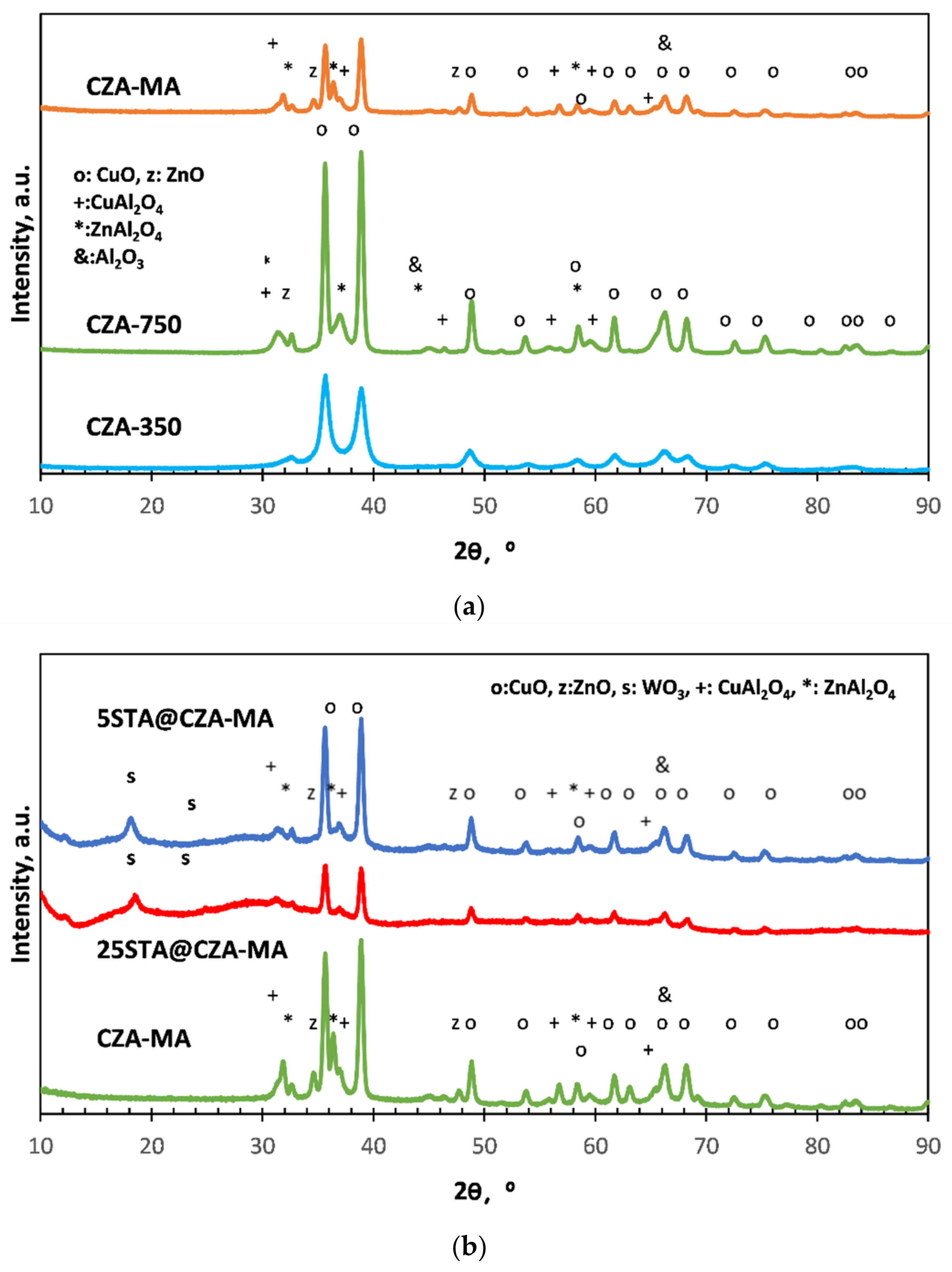
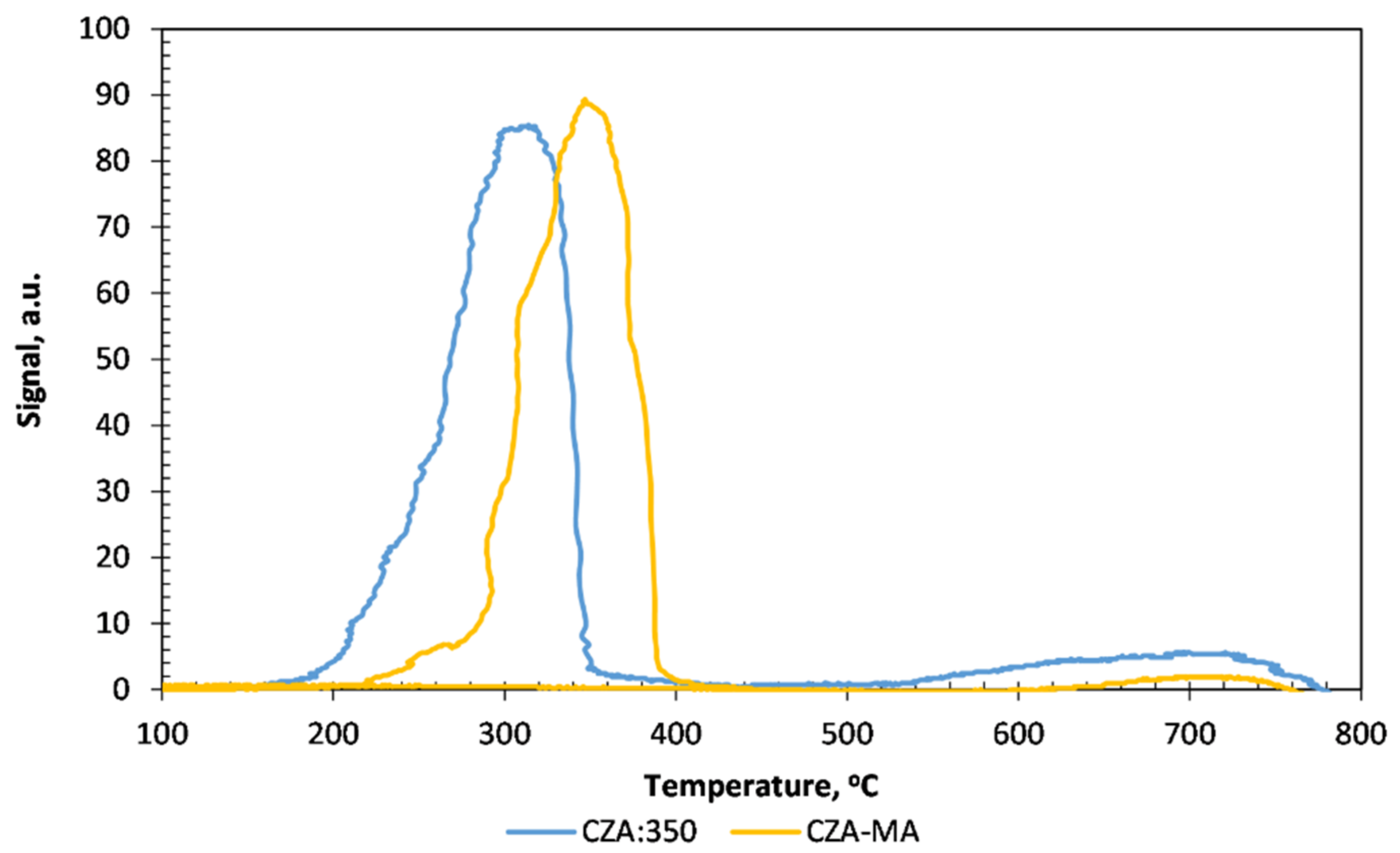

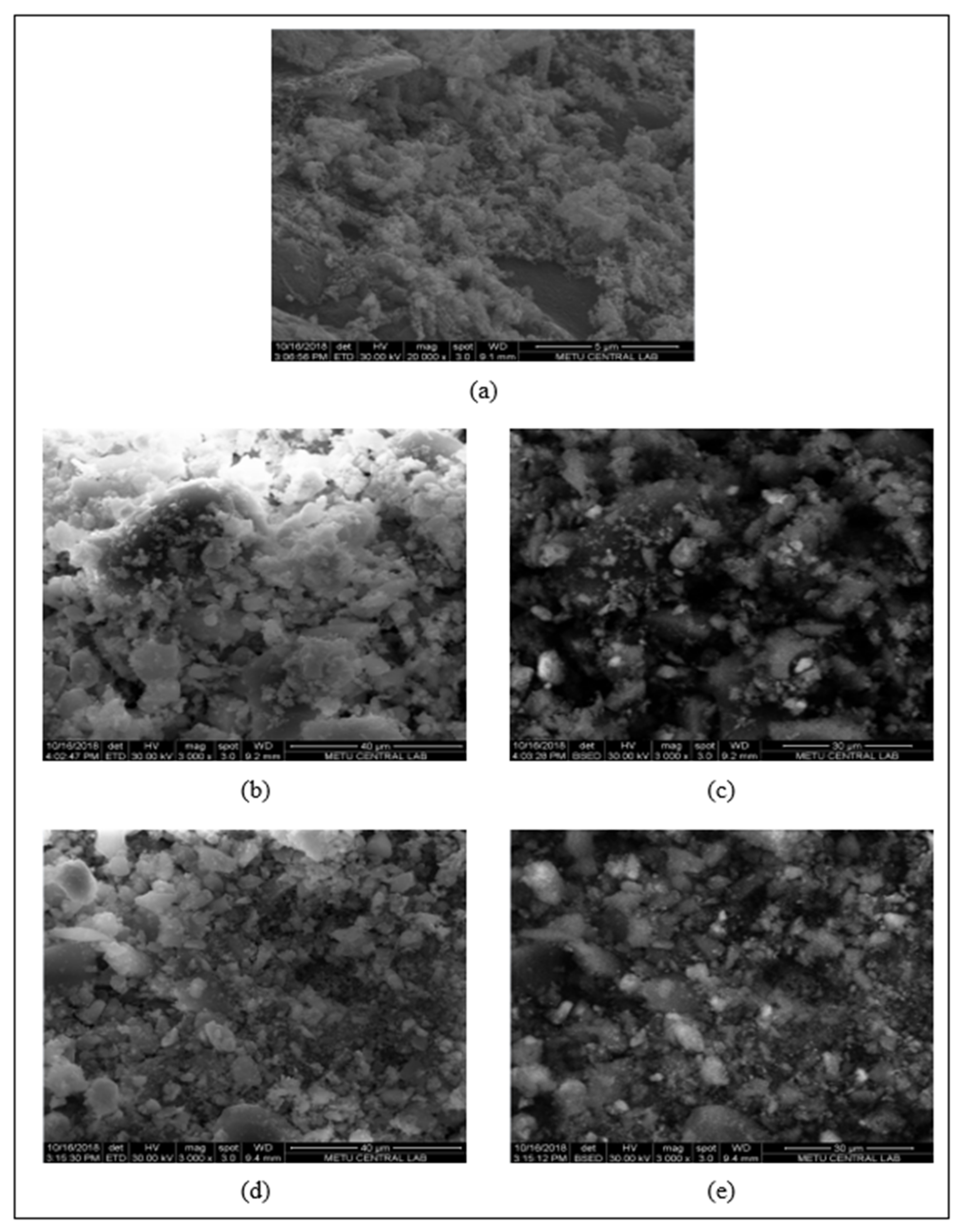
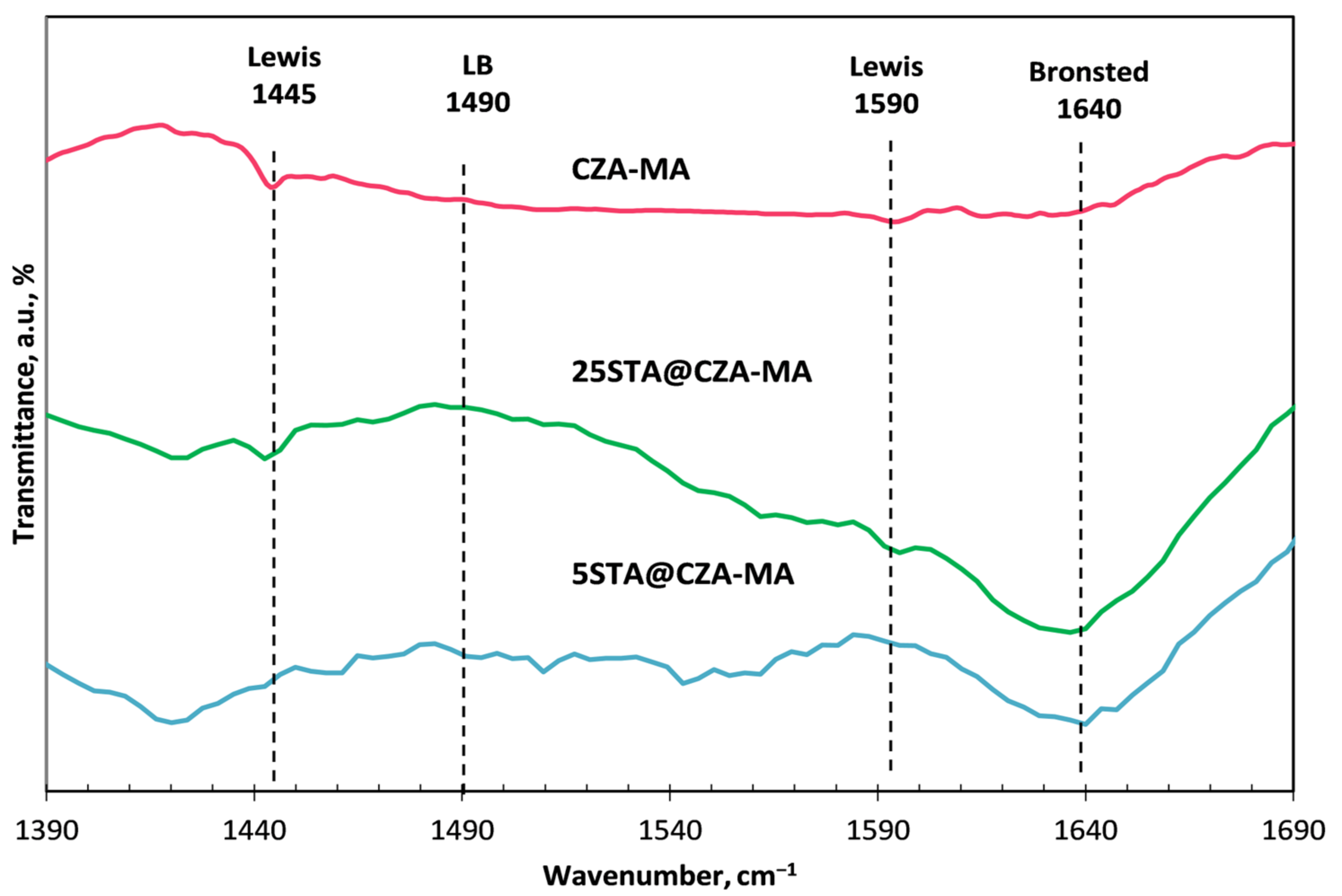
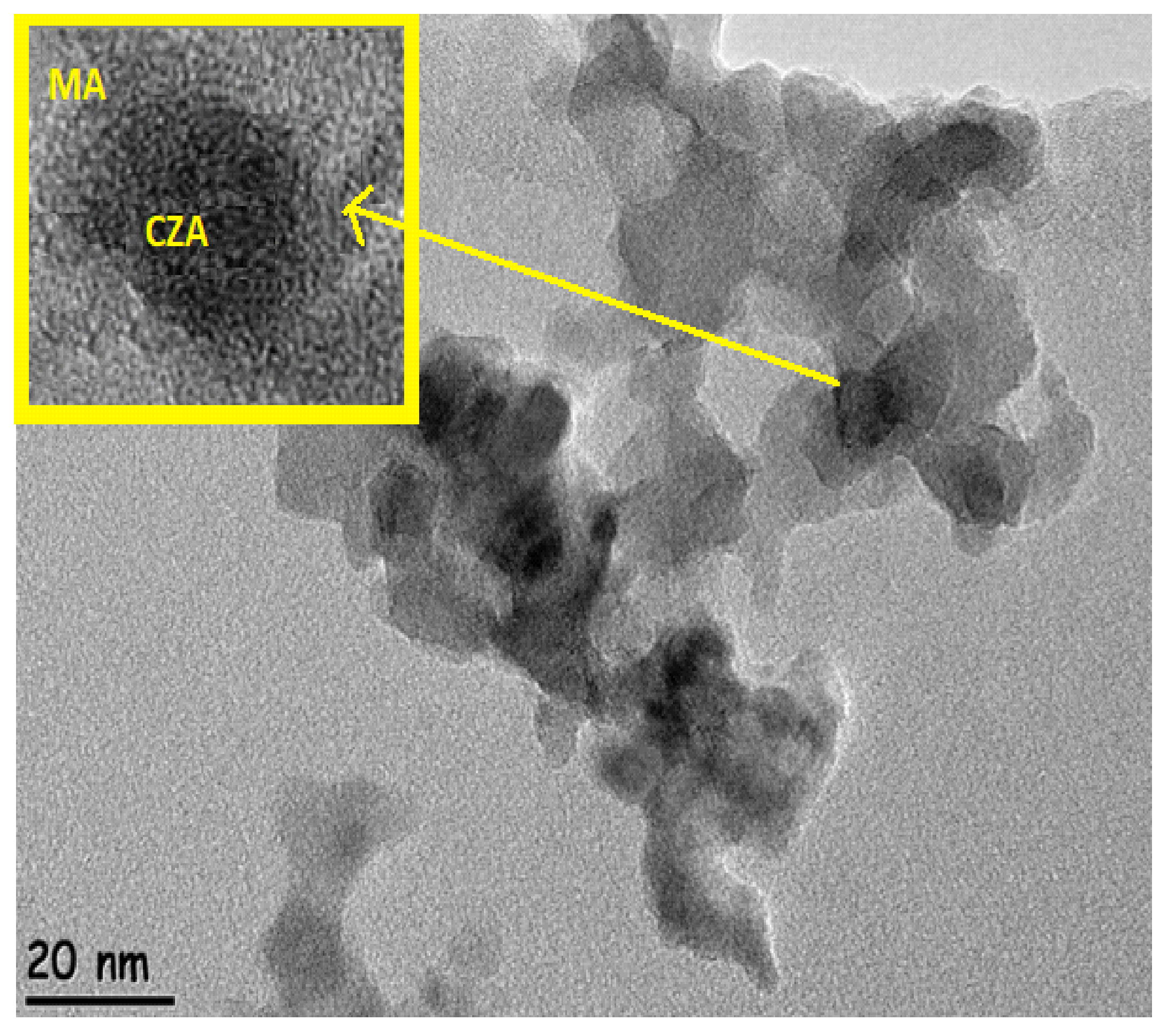
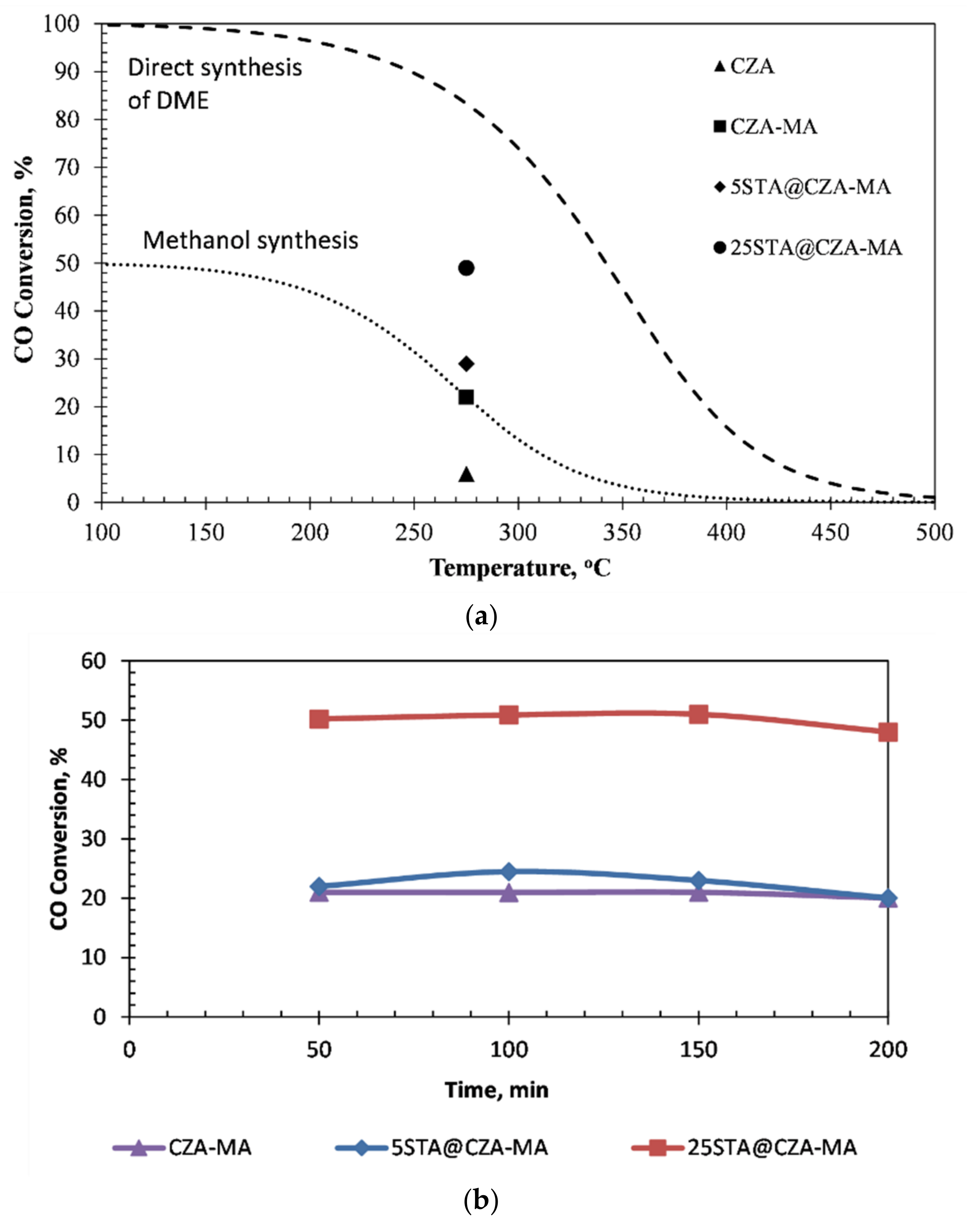

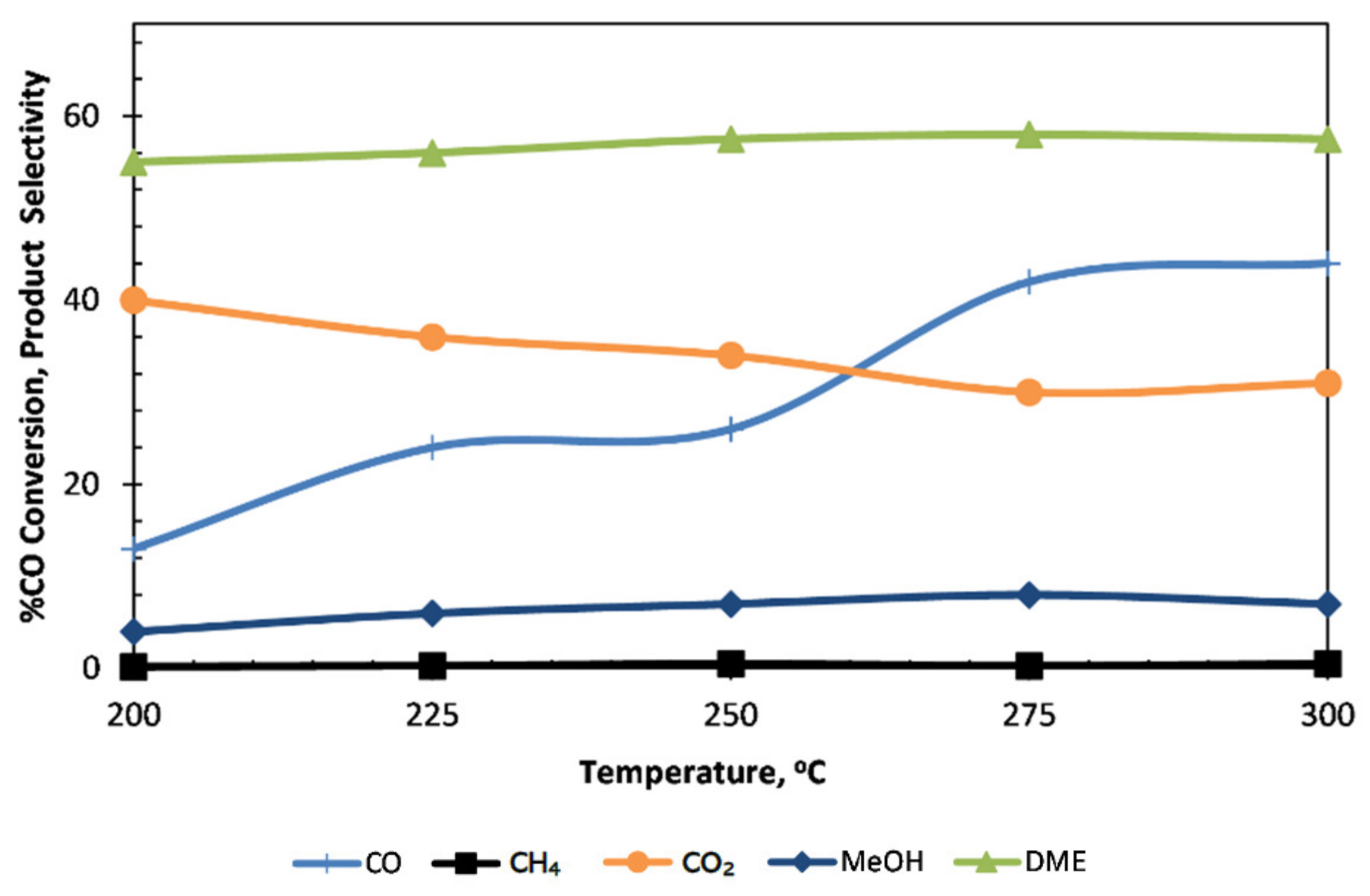
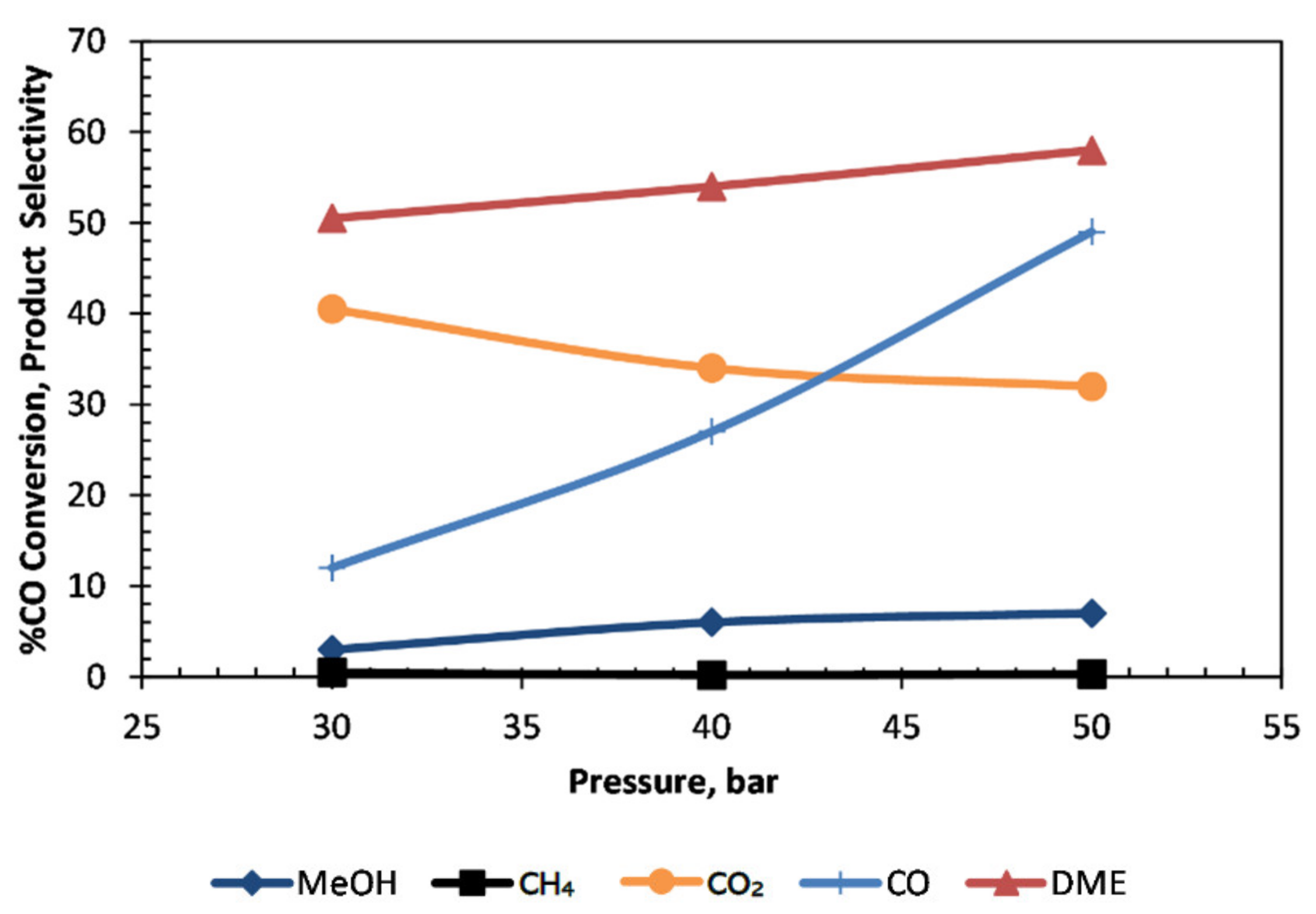
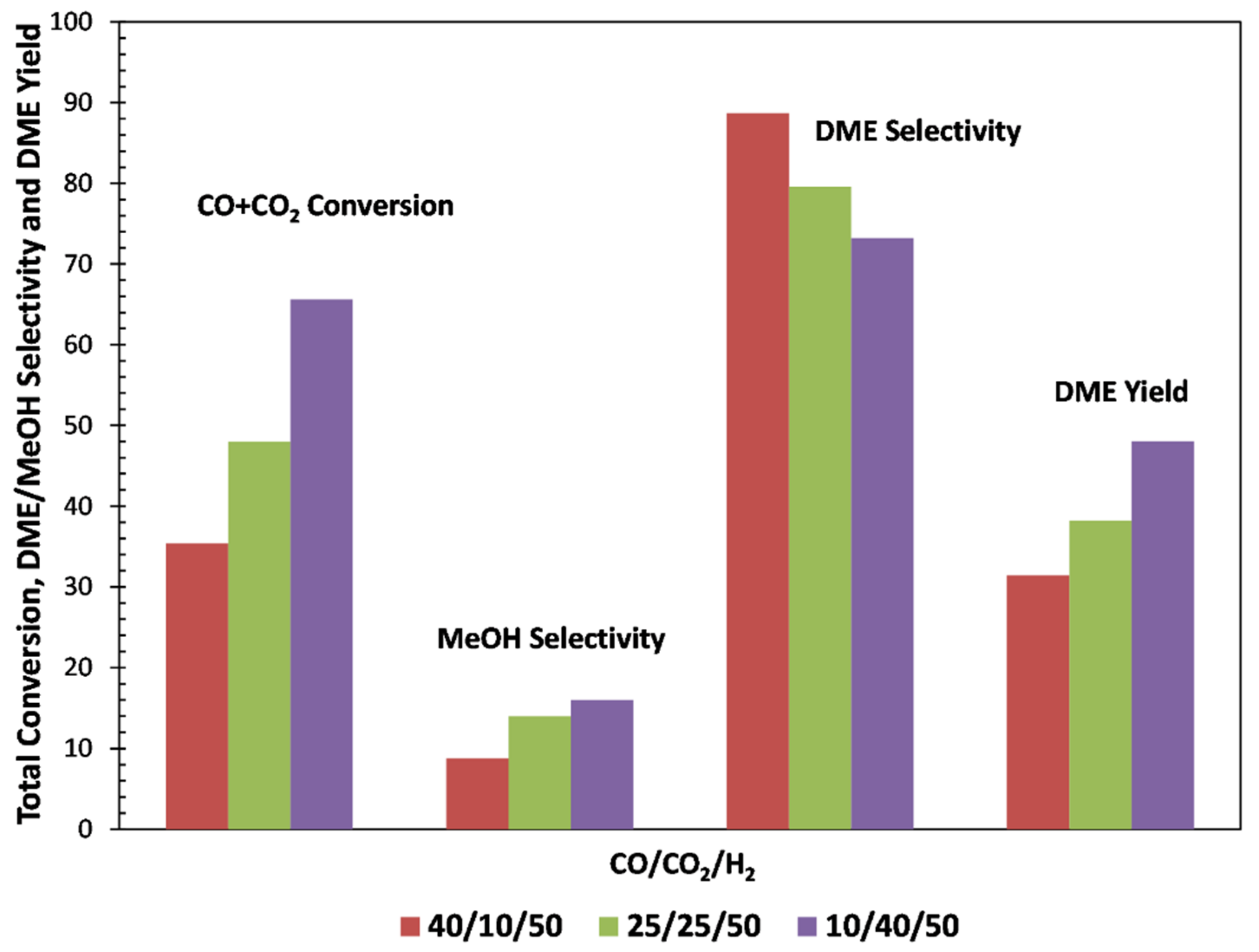
| Catalyst | Surface Area (m2/g) | Pore Diameter, nm | Pore Volume, cm3/g | SEM-EDS | ICP-MS |
|---|---|---|---|---|---|
| CZA-MA | 163 | 7.4 | 0.60 | — | — |
| 5STA@CZA-MA | 155 | 6.8 | 0.55 | 3.5 | 4.1 |
| 25STA@CZA-MA | 130 | 6.2 | 0.43 | 22 | 21.4 |
| Catalyst | CO Conversion, % | CH4 Selectivity, % | CO2 Selectivity, % | MeOH Selectivity, % | DME Selectivity, % |
|---|---|---|---|---|---|
| CZA-MA | 22 | 0.2 | 30.3 | 17.0 | 52.5 |
| 5STA@CZA-MA | 29 | 0.5 | 36.0 | 12.0 | 51.5 |
| 25STA@CZA-MA | 49 | 0.4 | 31.8 | 8.0 | 59.8 |
| Catalyst | CO Conversion, % | MeOH Selectivity, % | DME Selectivity, % | DME Yield, % |
|---|---|---|---|---|
| 25STA@CZA-MA | 49 | 8 | 59.8 | 29.3 |
| STA@MA + MSC [14] | 42 | 20 | 62 | 26.0 |
| 25STA@CZA [22] | 28 | 8.7 | 59.1 | 16.5 |
| CO/CO2/H2 Molar Ratio | Total Conversion, % (CO + CO2), % | MeOH Selectivity, % | CH4 Selectivity, % |
|---|---|---|---|
| 40/10/50 | 11.2 | 97.7 | 2.3 |
| 25/25/50 | 21 | 85.3 | 14.7 |
| 10/40/50 | 32 | 83.6 | 16.4 |
| Catalyst | % CO2 Conversion, % | CH4 Selectivity, % | CO Selectivity, % | MeOH Selectivity, % |
|---|---|---|---|---|
| CZA | 14.8 | 10.3 | 24.7 | 65.0 |
| CO/CO2/H2 Molar Ratio | DME Selectivity,% | CH4 Selectivity,% | MeOH Selectivity,% | Total Conversion,% (CO + CO2) | DME Yield, % |
|---|---|---|---|---|---|
| 40/10/50 | 88.7 | 2.5 | 8.8 | 35.4 | 31.4 |
| 25/25/50 | 79.6 | 6.4 | 14.0 | 48.0 | 38.2 |
| 10/40/50 | 73.2 | 10.8 | 16.0 | 65.6 | 48.0 |
Publisher’s Note: MDPI stays neutral with regard to jurisdictional claims in published maps and institutional affiliations. |
© 2022 by the authors. Licensee MDPI, Basel, Switzerland. This article is an open access article distributed under the terms and conditions of the Creative Commons Attribution (CC BY) license (https://creativecommons.org/licenses/by/4.0/).
Share and Cite
Karaman, B.P.; Oktar, N.; Doğu, G.; Dogu, T. Heteropolyacid Incorporated Bifunctional Core-Shell Catalysts for Dimethyl Ether Synthesis from Carbon Dioxide/Syngas. Catalysts 2022, 12, 1102. https://doi.org/10.3390/catal12101102
Karaman BP, Oktar N, Doğu G, Dogu T. Heteropolyacid Incorporated Bifunctional Core-Shell Catalysts for Dimethyl Ether Synthesis from Carbon Dioxide/Syngas. Catalysts. 2022; 12(10):1102. https://doi.org/10.3390/catal12101102
Chicago/Turabian StyleKaraman, Birce Pekmezci, Nuray Oktar, Gülşen Doğu, and Timur Dogu. 2022. "Heteropolyacid Incorporated Bifunctional Core-Shell Catalysts for Dimethyl Ether Synthesis from Carbon Dioxide/Syngas" Catalysts 12, no. 10: 1102. https://doi.org/10.3390/catal12101102
APA StyleKaraman, B. P., Oktar, N., Doğu, G., & Dogu, T. (2022). Heteropolyacid Incorporated Bifunctional Core-Shell Catalysts for Dimethyl Ether Synthesis from Carbon Dioxide/Syngas. Catalysts, 12(10), 1102. https://doi.org/10.3390/catal12101102








